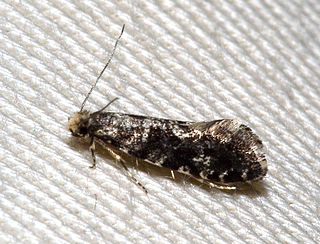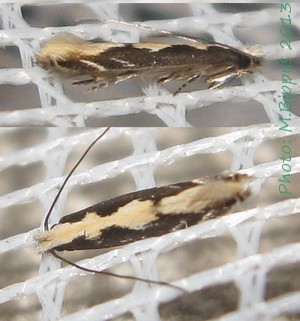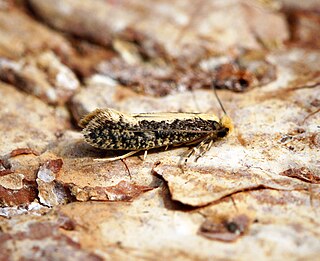Related Research Articles

Tineidae is a family of moths in the order Lepidoptera described by Pierre André Latreille in 1810. Collectively, they are known as fungus moths or tineid moths. The family contains considerably more than 3,000 species in more than 300 genera. Most of the tineid moths are small or medium-sized, with wings held roofwise over the body when at rest. They are particularly common in the Palaearctic, but many occur elsewhere, and some are found very widely as introduced species.

Tinea pellionella, the case-bearing clothes moth, is a species of tineoid moth in the family Tineidae, the fungus moths. This species has a cosmopolitan distribution, occurring nearly worldwide.

Amphixystis is a genus of moths belonging to the family Tineidae. The family was first described by Edward Meyrick in 1901.
Eudarcia is a genus of moths belonging to the family Tineidae.
Apreta is a moth genus, belonging to the family Tineidae. It contains only one species, Apreta paradoxella, which is found in California.
Miarotagmata is a genus of moths belonging to the family Tineidae. It contains only one species, Miarotagmata penetrata, which is found in South Africa and Zimbabwe.

Pyloetis is a moth genus, belonging to the family Tineidae. It consists of only one species, Pyloetis mimosae, which is found in Asia, including Japan and Taiwan.

Monopis crocicapitella, the pale-backed clothes moth, is a moth of the family Tineidae described by James Brackenridge Clemens in 1859. It has a nearly cosmopolitan distribution. It was first described from the eastern United States. It is particularly destructive of fabric and clothes.

Triaxomera fulvimitrella, the four-spotted clothes moth, is a moth of the family Tineidae. It is found in most of Europe, except Ireland, the Iberian Peninsula, Italy, Slovenia and most of the Balkan Peninsula. The habitat consists of woodlands.
Nemapogon signatella is a moth of the family Tineidae. It is found from Italy to the Balkan Peninsula and on Cyprus, as well as in Turkey, Jordan and Iran.
Eudarcia jaworskii is a moth of the family Tineidae. It is found in Turkey.

Tinea pallescentella, the large pale clothes moth, is a moth of the family Tineidae. It is found in most of Europe. It is also present in western North America, where it has been recorded from California. There are also records from South America and Australia.

Nemapogon clematella, the barred white clothes moth, is a moth of the family Tineidae. It is found in most of Europe and in North America, where it has been recorded from Maryland and North Carolina. The habitat consists of woodlands.
Nemapogon gliriella is a moth of the family Tineidae. It is found in Germany, Austria, the Czech Republic, Slovakia, Russia and Georgia.
Triaxomasia caprimulgella is a moth of the family Tineidae. It found in most of Europe, except Ireland, Luxembourg, Spain, Finland, the Baltic region, and the central part of the Balkan Peninsula.

Nemapogoninae is a fungus moth subfamily of the family Tineidae. It was described by Hinton in 1955.

The Meessiinae are a subfamily of moth of the family Tineidae.
Meessiidae is a family of moths in the superfamily Tineoidea. There are at least 2 genera and more than 80 described species in Meessiidae.
References
- ↑ Contributions to the knowledge of Palaearctic Tineidae Archived 2014-05-28 at the Wayback Machine